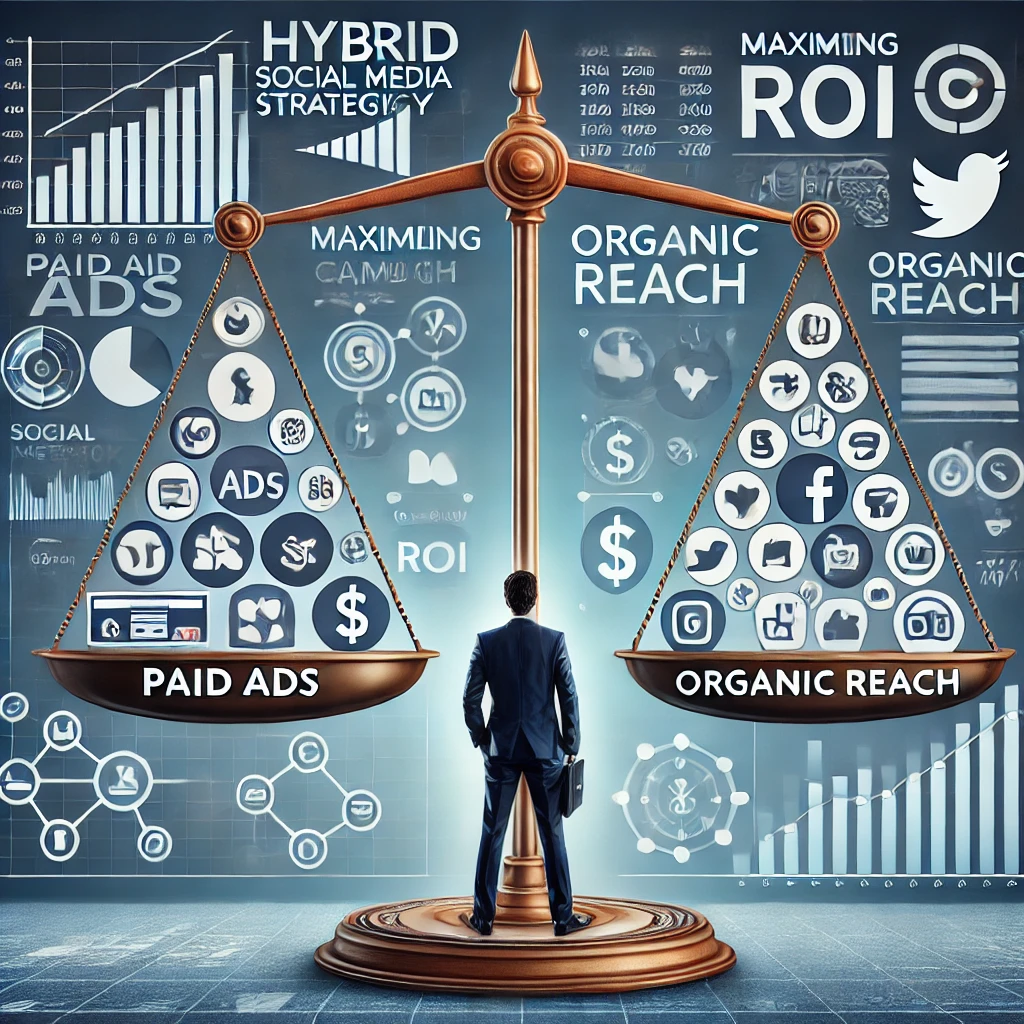
Social media often feels like an endless black hole of time and resources. You spend hours engaging, posting, and analyzing metrics, yet the results barely justify the effort. Should you invest in paid advertising to get quick wins, or focus on organic reach to build long-term engagement? The truth is, the most successful businesses strike a strategic balance between the two.
This guide will show you:
- How to create a hybrid social media strategy that maximizes ROI.
- Why relying solely on paid or organic methods can limit your growth.
- Time-saving techniques that allow you to achieve maximum impact without spending hours online.
The Problem: Misallocating Social Media Budget and Time
One of the biggest mistakes businesses make is improper budget allocation. Some overspend on ads expecting quick returns but neglect organic engagement. Others focus solely on organic reach, struggling to gain traction due to ever-changing algorithms.
Key Questions to Ask:
- Are your ads converting or simply increasing your ad spend?
- Is your organic reach driving meaningful engagement and sales?
- How much time are you spending versus the results you’re getting?
By answering these questions, you can start optimizing your social media approach for maximum efficiency.
Paid Ads vs. Organic Strategies: Why One Isn’t Enough
The Strengths of Paid Ads:
- Immediate visibility to target audiences.
- Highly customizable for specific demographics.
- Great for launching new products and time-sensitive promotions.
The Weaknesses:
- Expensive if not managed properly.
- Short-lived impact—once you stop spending, visibility drops.
- Requires continuous optimization for effectiveness.
The Strengths of Organic Strategies:
- Builds trust and brand authority over time.
- Cost-effective and sustainable for long-term engagement.
- Encourages community building and brand loyalty.
The Weaknesses:
- Limited reach due to declining organic visibility on social platforms.
- Slow to generate results, requiring consistency and patience.
A Balanced Approach: How Paid and Organic Work Together
Instead of choosing one strategy over the other, smart businesses integrate both for maximum ROI.
How They Complement Each Other:
- Use paid ads to drive traffic – Boost high-performing organic content with ad spend.
- Build long-term engagement with organic content – Nurture your audience through valuable, non-promotional content.
- Leverage retargeting – Show ads to users who have previously engaged with your organic posts.
Example: A clothing brand launches a new product using paid ads for immediate exposure. Simultaneously, they use organic posts, influencer partnerships, and customer testimonials to maintain long-term engagement.
Proven Strategies to Maximize Social Media ROI
1. Time-Saving Social Media Techniques
- Use Scheduling Tools: Platforms like Hootsuite, Buffer, and Later allow you to automate posts.
- Batch Content Creation: Set aside a few hours weekly to plan and create content in bulk.
- Engage in Short Bursts: Set specific time slots daily for responding to comments/messages instead of constantly checking.
2. Prioritizing High-Impact Activities
- Identify Your Best-Performing Platforms: Double down on the platforms where your audience engages the most.
- Focus on High-ROI Actions: Prioritize content formats that generate the most reach and conversions (e.g., videos, user-generated content).
- Repurpose Content Across Platforms: Convert a single blog post into multiple pieces of content (infographics, short videos, carousel posts).
3. Leveraging Analytics for Smarter Decisions
- Track Key Metrics: Focus on engagement rate, conversion rate, and cost per acquisition instead of vanity metrics like followers.
- A/B Test Your Ads and Content: Optimize your posts and ad campaigns by testing different versions.
- Adjust Based on Performance Data: Review analytics weekly and pivot strategies when necessary.
Case Studies: Success Stories of Balanced Strategies
Case Study 1: eCommerce Brand Scaling Sales with a Hybrid Approach
Challenge: Increase sales without over-reliance on ad spend.
Solution:
- Used paid ads for short-term traffic boosts during promotions.
- Invested in organic content (customer testimonials, product demos) for continuous engagement.
Results:
- 25% sales increase in 6 months.
- 40% higher engagement on organic posts, leading to a lower cost per conversion on paid ads.
Case Study 2: Tech Startup Using Social Media for Brand Awareness
Challenge: Build brand credibility with a limited budget.
Solution:
- Leveraged paid ads to target high-intent audiences.
- Created organic thought leadership content to maintain authority and engagement.
- Used influencers to extend reach without heavy ad spend.
Results:
- Increased website traffic by 60% within three months.
- Reduced ad costs by 30% due to higher engagement on organic content.
FAQs: Addressing Common Concerns
1. How do I decide on the right budget for paid ads? Start small and analyze performance. Allocate 10-20% of your marketing budget to ads, test different audiences, and scale based on successful results.
2. Can I succeed with only organic strategies? It’s possible, but difficult. Organic growth is slower, and algorithms favor paid content. A mix of organic and paid strategies delivers the best results.
3. How do I measure the success of my hybrid strategy? Track conversion rates, engagement levels, cost per acquisition, and retention rates. Consistently optimize based on data insights.
Final Takeaway: Mastering the Art of Social Media ROI
Maximizing your ROI on social media requires a balanced approach. By strategically combining paid and organic efforts, leveraging automation, and using data-driven insights, you can achieve great results without spending excessive time online.
Want more guidance? Consult with a social media marketing expert to refine your strategy today!
Learn about Boost Your Brand’s Visibility with Bossy Digital Marketing!